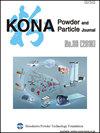Electrodynamic Sorting of Industrial Scrap Metal
IF 3.2
4区 材料科学
Q3 ENGINEERING, CHEMICAL
引用次数: 4
Abstract
Electrodynamic sorting (EDX) is a new technology developed to sort industrial scrap metals. Under the present embodiment, an electromagnet is placed directly underneath a conveyor belt and then excited by an alternating electrical current to produce a time-varying magnetic field. As scrap particles pass through the field overhead, electrical eddy currents are induced throughout their volumes and then repelled away. If the frequency of excitation is very high (e.g., 12 kHz), then the lightweight aluminum particles tend to jump far more dramatically than heavier materials like copper, brass, and zinc. To demonstrate the principle, a small-scale prototype was assembled and tested. Using an 8-inch (20 cm) lane width, the system could process industrial scrap Zorba at a throughput of over 550 lbs/hour (225 kg/h) with an aluminum grade of 97.6 % and a recovery of 93 %.工业废金属的电动分选
电动分选是一项新兴的工业废金属分选技术。在本实施例下,电磁铁直接放置在传送带下方,然后由交流电流激发以产生时变磁场。当废料颗粒穿过头顶的电场时,电涡流在它们的整个体积中产生,然后被排斥。如果激发频率非常高(例如,12千赫),那么轻的铝粒子往往比铜、黄铜和锌等较重的材料跳跃得更剧烈。为了证明这一原理,组装了一个小型原型并进行了测试。使用8英寸(20厘米)的车道宽度,该系统可以以超过550磅/小时(225公斤/小时)的吞吐量处理工业废料Zorba,铝品位为97.6%,回收率为93%。
本文章由计算机程序翻译,如有差异,请以英文原文为准。
求助全文
约1分钟内获得全文
求助全文
来源期刊

KONA Powder and Particle Journal
工程技术-材料科学:综合
CiteScore
8.40
自引率
4.90%
发文量
35
审稿时长
>12 weeks
期刊介绍:
KONA publishes papers in the broad field of powder science and technology, ranging from fundamental principles to practical applications. Papers describing technological experience and critical reviews of existing knowledge in special areas are also welcome.
 求助内容:
求助内容: 应助结果提醒方式:
应助结果提醒方式:


